Mechanical Properties of Fly Ash Based Green Concrete Report
VerifiedAdded on 2022/10/19
|15
|3558
|12
Report
AI Summary
This report investigates the mechanical properties of fly ash-based green concrete, a sustainable alternative to traditional concrete, focusing on its compressive strength and durability. The study highlights the environmental benefits of utilizing fly ash, a byproduct of coal combustion, to reduce CO2 emissions associated with cement production. The report discusses the concept of fly ash, its various properties, and the issues related to its disposal, emphasizing the need for its effective utilization in the construction industry. It explores the use of fly ash in concrete, detailing its impact on concrete performance, including enhanced long-term strength and reduced permeability. The report also presents data on the annual production and utilization of fly ash in different countries, illustrating the potential for widespread adoption of this eco-friendly building material. Finally, it provides an overview of the mix proportion and the chemical composition of cement, supporting the analysis of fly ash concrete's mechanical characteristics.
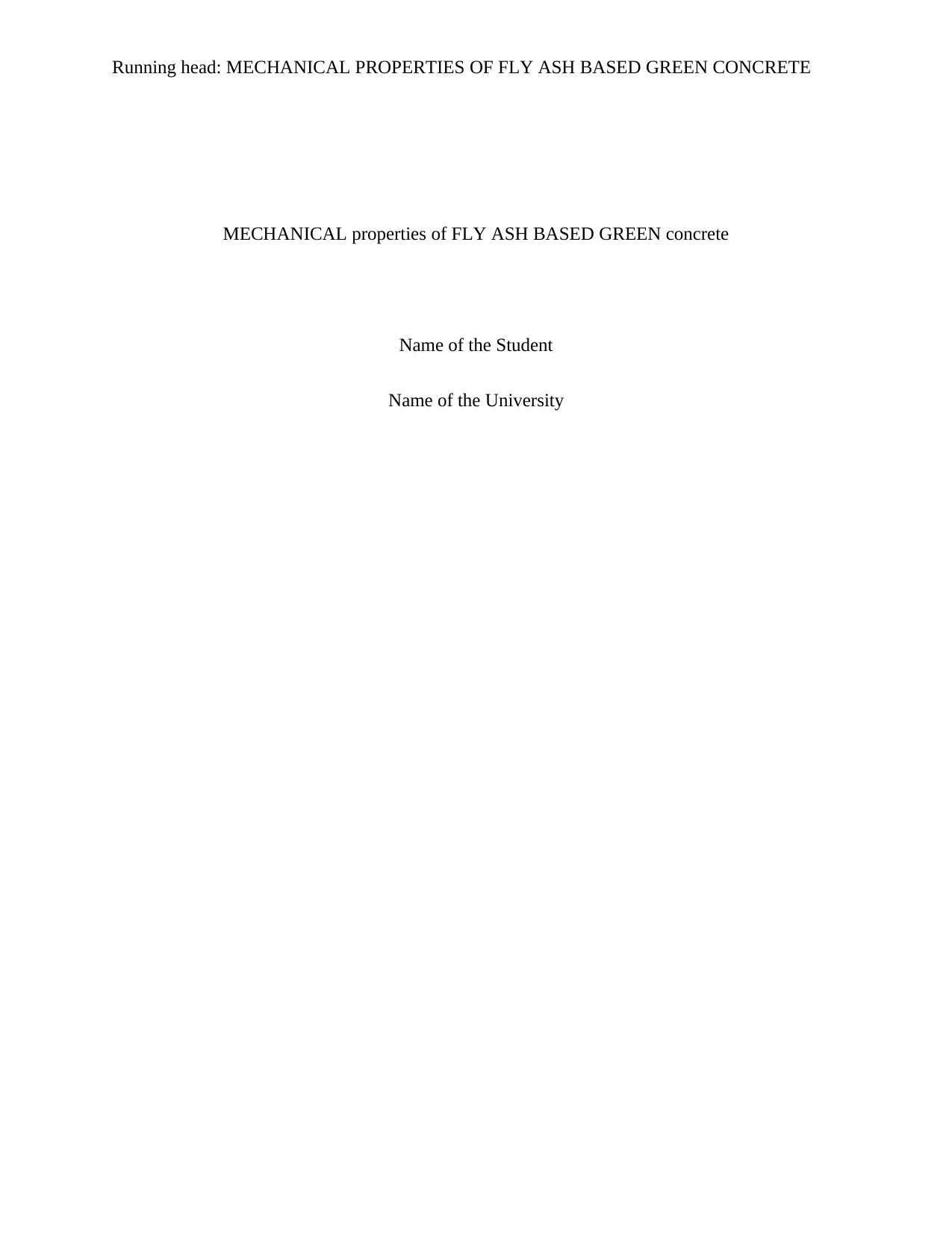
Running head: MECHANICAL PROPERTIES OF FLY ASH BASED GREEN CONCRETE
MECHANICAL properties of FLY ASH BASED GREEN concrete
Name of the Student
Name of the University
MECHANICAL properties of FLY ASH BASED GREEN concrete
Name of the Student
Name of the University
Paraphrase This Document
Need a fresh take? Get an instant paraphrase of this document with our AI Paraphraser
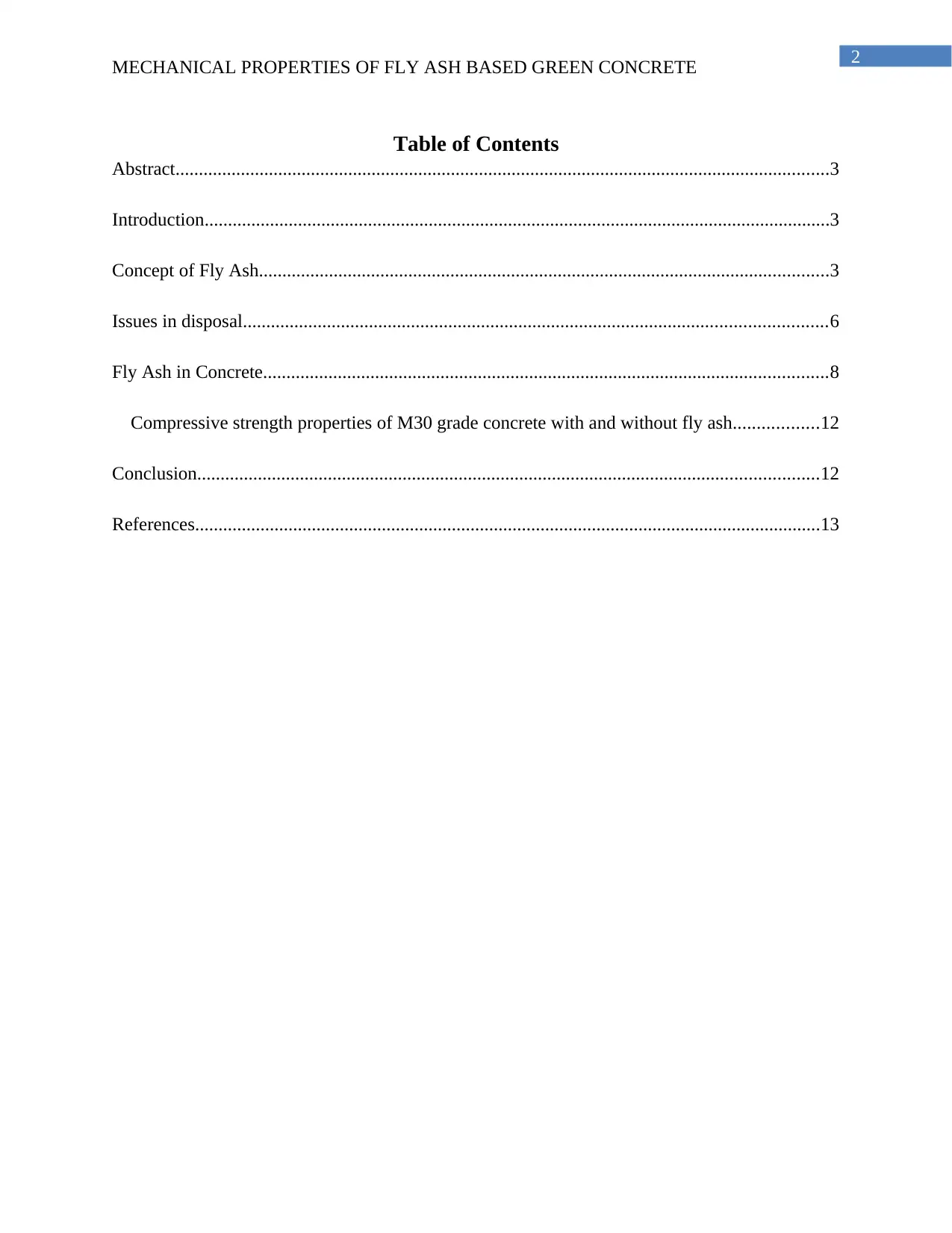
2
MECHANICAL PROPERTIES OF FLY ASH BASED GREEN CONCRETE
Table of Contents
Abstract............................................................................................................................................3
Introduction......................................................................................................................................3
Concept of Fly Ash..........................................................................................................................3
Issues in disposal.............................................................................................................................6
Fly Ash in Concrete.........................................................................................................................8
Compressive strength properties of M30 grade concrete with and without fly ash..................12
Conclusion.....................................................................................................................................12
References......................................................................................................................................13
MECHANICAL PROPERTIES OF FLY ASH BASED GREEN CONCRETE
Table of Contents
Abstract............................................................................................................................................3
Introduction......................................................................................................................................3
Concept of Fly Ash..........................................................................................................................3
Issues in disposal.............................................................................................................................6
Fly Ash in Concrete.........................................................................................................................8
Compressive strength properties of M30 grade concrete with and without fly ash..................12
Conclusion.....................................................................................................................................12
References......................................................................................................................................13
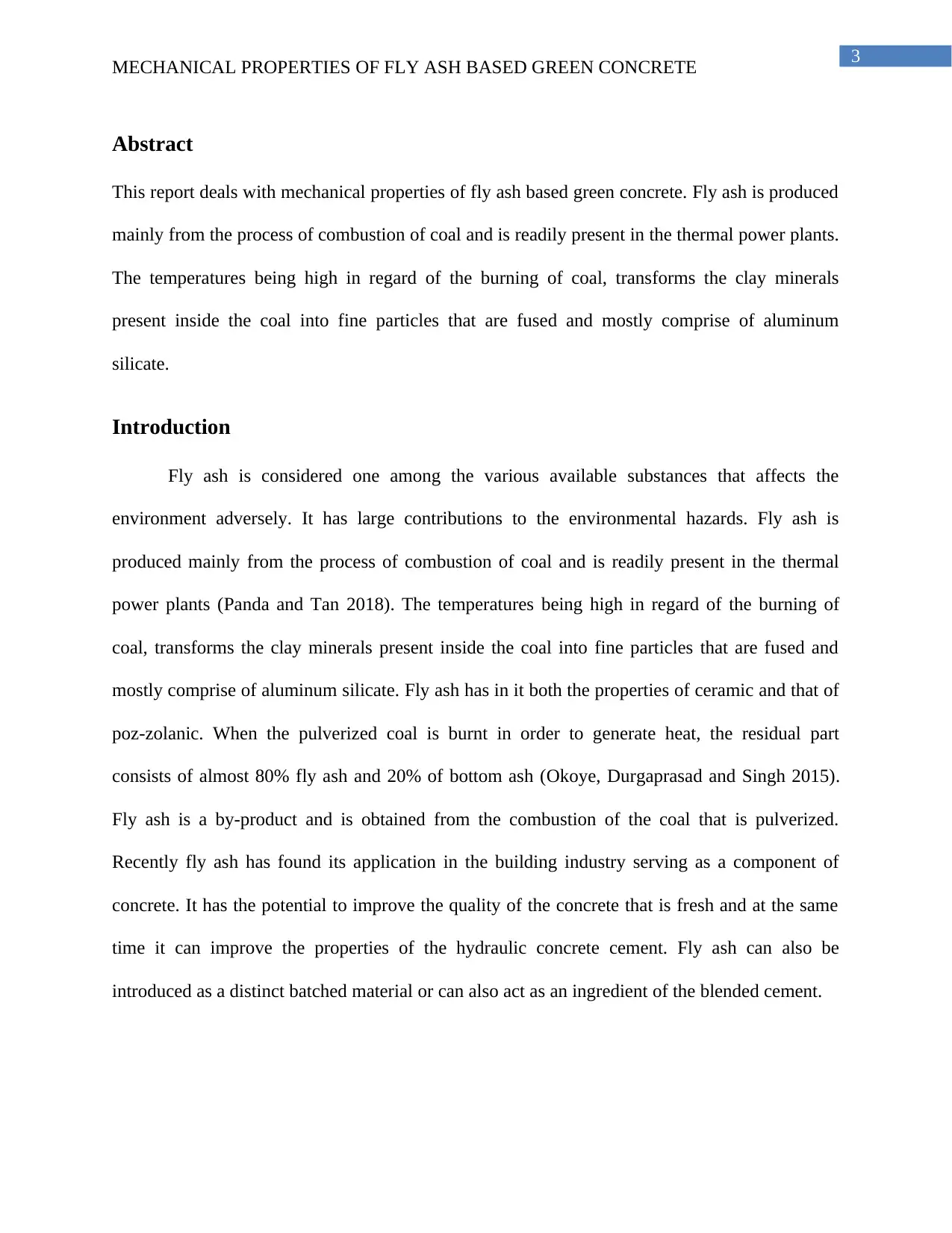
3
MECHANICAL PROPERTIES OF FLY ASH BASED GREEN CONCRETE
Abstract
This report deals with mechanical properties of fly ash based green concrete. Fly ash is produced
mainly from the process of combustion of coal and is readily present in the thermal power plants.
The temperatures being high in regard of the burning of coal, transforms the clay minerals
present inside the coal into fine particles that are fused and mostly comprise of aluminum
silicate.
Introduction
Fly ash is considered one among the various available substances that affects the
environment adversely. It has large contributions to the environmental hazards. Fly ash is
produced mainly from the process of combustion of coal and is readily present in the thermal
power plants (Panda and Tan 2018). The temperatures being high in regard of the burning of
coal, transforms the clay minerals present inside the coal into fine particles that are fused and
mostly comprise of aluminum silicate. Fly ash has in it both the properties of ceramic and that of
poz-zolanic. When the pulverized coal is burnt in order to generate heat, the residual part
consists of almost 80% fly ash and 20% of bottom ash (Okoye, Durgaprasad and Singh 2015).
Fly ash is a by-product and is obtained from the combustion of the coal that is pulverized.
Recently fly ash has found its application in the building industry serving as a component of
concrete. It has the potential to improve the quality of the concrete that is fresh and at the same
time it can improve the properties of the hydraulic concrete cement. Fly ash can also be
introduced as a distinct batched material or can also act as an ingredient of the blended cement.
MECHANICAL PROPERTIES OF FLY ASH BASED GREEN CONCRETE
Abstract
This report deals with mechanical properties of fly ash based green concrete. Fly ash is produced
mainly from the process of combustion of coal and is readily present in the thermal power plants.
The temperatures being high in regard of the burning of coal, transforms the clay minerals
present inside the coal into fine particles that are fused and mostly comprise of aluminum
silicate.
Introduction
Fly ash is considered one among the various available substances that affects the
environment adversely. It has large contributions to the environmental hazards. Fly ash is
produced mainly from the process of combustion of coal and is readily present in the thermal
power plants (Panda and Tan 2018). The temperatures being high in regard of the burning of
coal, transforms the clay minerals present inside the coal into fine particles that are fused and
mostly comprise of aluminum silicate. Fly ash has in it both the properties of ceramic and that of
poz-zolanic. When the pulverized coal is burnt in order to generate heat, the residual part
consists of almost 80% fly ash and 20% of bottom ash (Okoye, Durgaprasad and Singh 2015).
Fly ash is a by-product and is obtained from the combustion of the coal that is pulverized.
Recently fly ash has found its application in the building industry serving as a component of
concrete. It has the potential to improve the quality of the concrete that is fresh and at the same
time it can improve the properties of the hydraulic concrete cement. Fly ash can also be
introduced as a distinct batched material or can also act as an ingredient of the blended cement.
⊘ This is a preview!⊘
Do you want full access?
Subscribe today to unlock all pages.

Trusted by 1+ million students worldwide
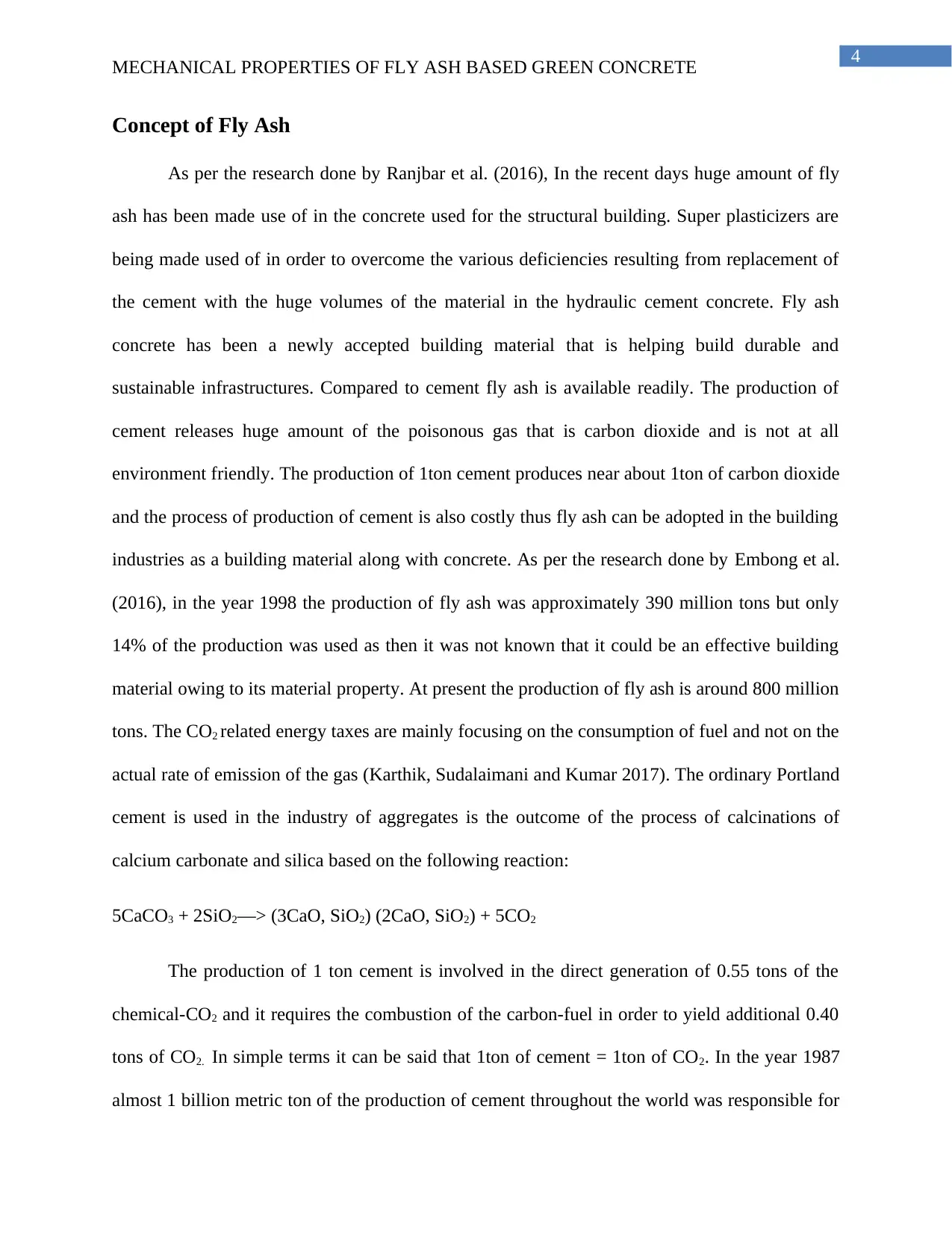
4
MECHANICAL PROPERTIES OF FLY ASH BASED GREEN CONCRETE
Concept of Fly Ash
As per the research done by Ranjbar et al. (2016), In the recent days huge amount of fly
ash has been made use of in the concrete used for the structural building. Super plasticizers are
being made used of in order to overcome the various deficiencies resulting from replacement of
the cement with the huge volumes of the material in the hydraulic cement concrete. Fly ash
concrete has been a newly accepted building material that is helping build durable and
sustainable infrastructures. Compared to cement fly ash is available readily. The production of
cement releases huge amount of the poisonous gas that is carbon dioxide and is not at all
environment friendly. The production of 1ton cement produces near about 1ton of carbon dioxide
and the process of production of cement is also costly thus fly ash can be adopted in the building
industries as a building material along with concrete. As per the research done by Embong et al.
(2016), in the year 1998 the production of fly ash was approximately 390 million tons but only
14% of the production was used as then it was not known that it could be an effective building
material owing to its material property. At present the production of fly ash is around 800 million
tons. The CO2 related energy taxes are mainly focusing on the consumption of fuel and not on the
actual rate of emission of the gas (Karthik, Sudalaimani and Kumar 2017). The ordinary Portland
cement is used in the industry of aggregates is the outcome of the process of calcinations of
calcium carbonate and silica based on the following reaction:
5CaCO3 + 2SiO2—> (3CaO, SiO2) (2CaO, SiO2) + 5CO2
The production of 1 ton cement is involved in the direct generation of 0.55 tons of the
chemical-CO2 and it requires the combustion of the carbon-fuel in order to yield additional 0.40
tons of CO2. In simple terms it can be said that 1ton of cement = 1ton of CO2. In the year 1987
almost 1 billion metric ton of the production of cement throughout the world was responsible for
MECHANICAL PROPERTIES OF FLY ASH BASED GREEN CONCRETE
Concept of Fly Ash
As per the research done by Ranjbar et al. (2016), In the recent days huge amount of fly
ash has been made use of in the concrete used for the structural building. Super plasticizers are
being made used of in order to overcome the various deficiencies resulting from replacement of
the cement with the huge volumes of the material in the hydraulic cement concrete. Fly ash
concrete has been a newly accepted building material that is helping build durable and
sustainable infrastructures. Compared to cement fly ash is available readily. The production of
cement releases huge amount of the poisonous gas that is carbon dioxide and is not at all
environment friendly. The production of 1ton cement produces near about 1ton of carbon dioxide
and the process of production of cement is also costly thus fly ash can be adopted in the building
industries as a building material along with concrete. As per the research done by Embong et al.
(2016), in the year 1998 the production of fly ash was approximately 390 million tons but only
14% of the production was used as then it was not known that it could be an effective building
material owing to its material property. At present the production of fly ash is around 800 million
tons. The CO2 related energy taxes are mainly focusing on the consumption of fuel and not on the
actual rate of emission of the gas (Karthik, Sudalaimani and Kumar 2017). The ordinary Portland
cement is used in the industry of aggregates is the outcome of the process of calcinations of
calcium carbonate and silica based on the following reaction:
5CaCO3 + 2SiO2—> (3CaO, SiO2) (2CaO, SiO2) + 5CO2
The production of 1 ton cement is involved in the direct generation of 0.55 tons of the
chemical-CO2 and it requires the combustion of the carbon-fuel in order to yield additional 0.40
tons of CO2. In simple terms it can be said that 1ton of cement = 1ton of CO2. In the year 1987
almost 1 billion metric ton of the production of cement throughout the world was responsible for
Paraphrase This Document
Need a fresh take? Get an instant paraphrase of this document with our AI Paraphraser
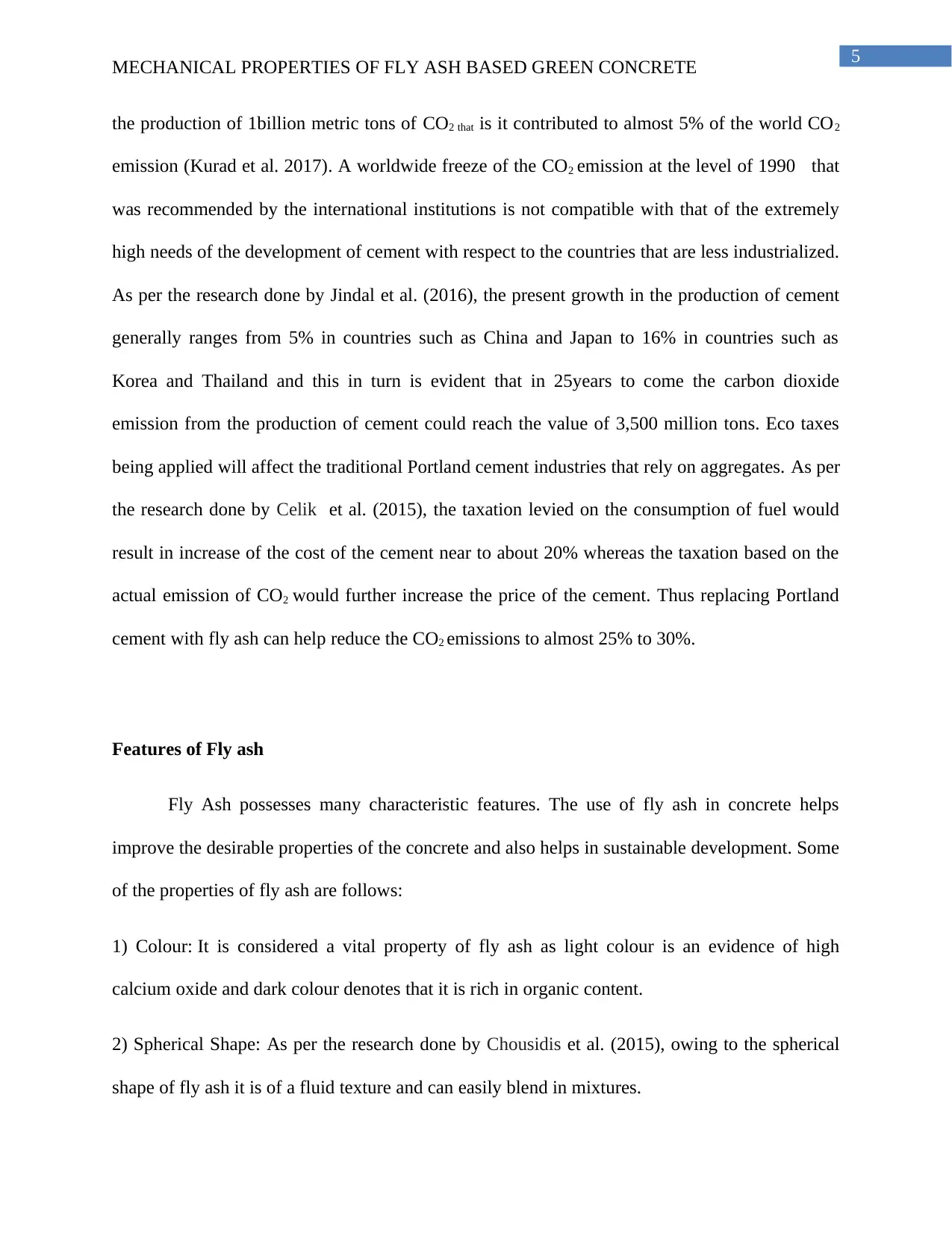
5
MECHANICAL PROPERTIES OF FLY ASH BASED GREEN CONCRETE
the production of 1billion metric tons of CO2 that is it contributed to almost 5% of the world CO2
emission (Kurad et al. 2017). A worldwide freeze of the CO2 emission at the level of 1990 that
was recommended by the international institutions is not compatible with that of the extremely
high needs of the development of cement with respect to the countries that are less industrialized.
As per the research done by Jindal et al. (2016), the present growth in the production of cement
generally ranges from 5% in countries such as China and Japan to 16% in countries such as
Korea and Thailand and this in turn is evident that in 25years to come the carbon dioxide
emission from the production of cement could reach the value of 3,500 million tons. Eco taxes
being applied will affect the traditional Portland cement industries that rely on aggregates. As per
the research done by Celik et al. (2015), the taxation levied on the consumption of fuel would
result in increase of the cost of the cement near to about 20% whereas the taxation based on the
actual emission of CO2 would further increase the price of the cement. Thus replacing Portland
cement with fly ash can help reduce the CO2 emissions to almost 25% to 30%.
Features of Fly ash
Fly Ash possesses many characteristic features. The use of fly ash in concrete helps
improve the desirable properties of the concrete and also helps in sustainable development. Some
of the properties of fly ash are follows:
1) Colour: It is considered a vital property of fly ash as light colour is an evidence of high
calcium oxide and dark colour denotes that it is rich in organic content.
2) Spherical Shape: As per the research done by Chousidis et al. (2015), owing to the spherical
shape of fly ash it is of a fluid texture and can easily blend in mixtures.
MECHANICAL PROPERTIES OF FLY ASH BASED GREEN CONCRETE
the production of 1billion metric tons of CO2 that is it contributed to almost 5% of the world CO2
emission (Kurad et al. 2017). A worldwide freeze of the CO2 emission at the level of 1990 that
was recommended by the international institutions is not compatible with that of the extremely
high needs of the development of cement with respect to the countries that are less industrialized.
As per the research done by Jindal et al. (2016), the present growth in the production of cement
generally ranges from 5% in countries such as China and Japan to 16% in countries such as
Korea and Thailand and this in turn is evident that in 25years to come the carbon dioxide
emission from the production of cement could reach the value of 3,500 million tons. Eco taxes
being applied will affect the traditional Portland cement industries that rely on aggregates. As per
the research done by Celik et al. (2015), the taxation levied on the consumption of fuel would
result in increase of the cost of the cement near to about 20% whereas the taxation based on the
actual emission of CO2 would further increase the price of the cement. Thus replacing Portland
cement with fly ash can help reduce the CO2 emissions to almost 25% to 30%.
Features of Fly ash
Fly Ash possesses many characteristic features. The use of fly ash in concrete helps
improve the desirable properties of the concrete and also helps in sustainable development. Some
of the properties of fly ash are follows:
1) Colour: It is considered a vital property of fly ash as light colour is an evidence of high
calcium oxide and dark colour denotes that it is rich in organic content.
2) Spherical Shape: As per the research done by Chousidis et al. (2015), owing to the spherical
shape of fly ash it is of a fluid texture and can easily blend in mixtures.
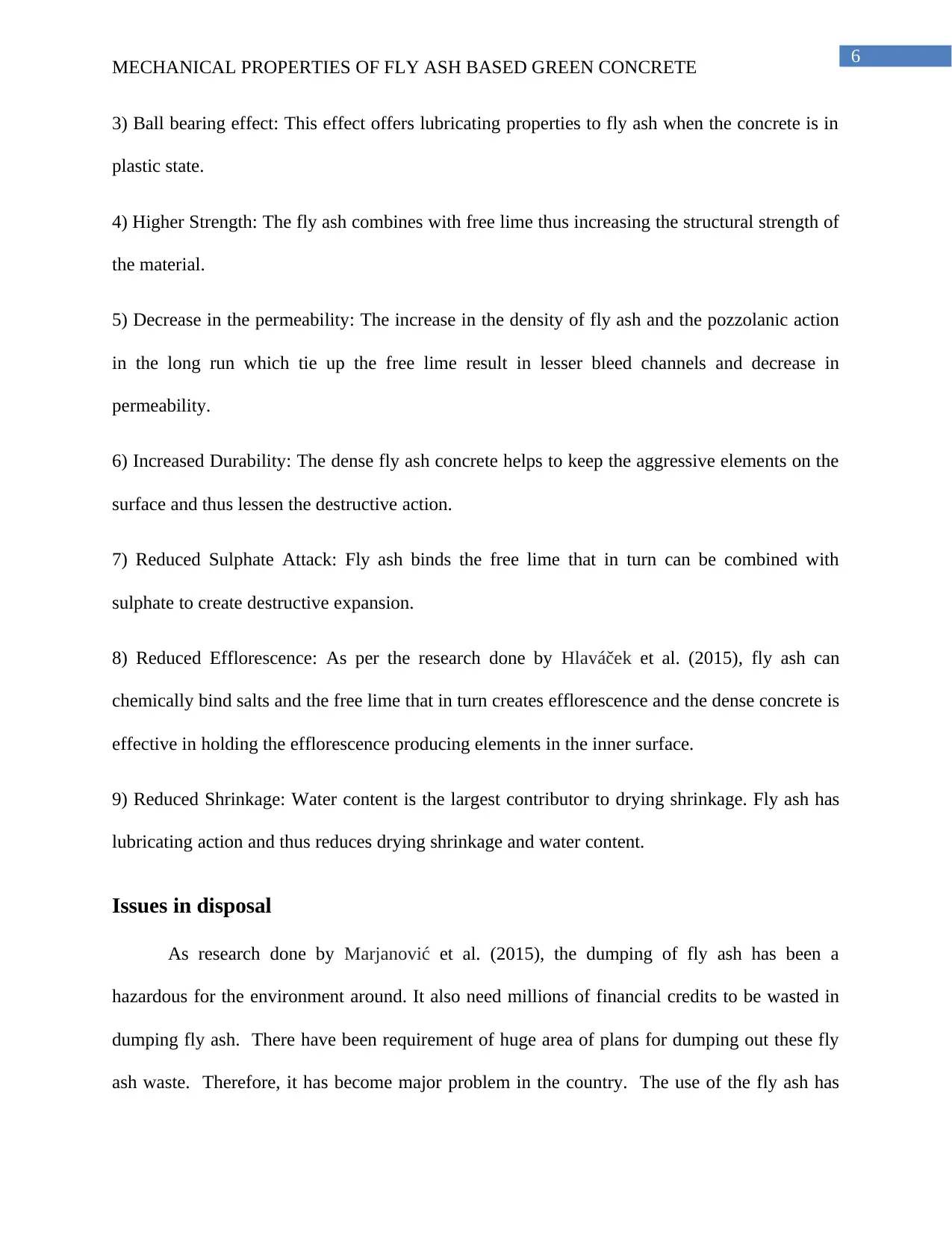
6
MECHANICAL PROPERTIES OF FLY ASH BASED GREEN CONCRETE
3) Ball bearing effect: This effect offers lubricating properties to fly ash when the concrete is in
plastic state.
4) Higher Strength: The fly ash combines with free lime thus increasing the structural strength of
the material.
5) Decrease in the permeability: The increase in the density of fly ash and the pozzolanic action
in the long run which tie up the free lime result in lesser bleed channels and decrease in
permeability.
6) Increased Durability: The dense fly ash concrete helps to keep the aggressive elements on the
surface and thus lessen the destructive action.
7) Reduced Sulphate Attack: Fly ash binds the free lime that in turn can be combined with
sulphate to create destructive expansion.
8) Reduced Efflorescence: As per the research done by Hlaváček et al. (2015), fly ash can
chemically bind salts and the free lime that in turn creates efflorescence and the dense concrete is
effective in holding the efflorescence producing elements in the inner surface.
9) Reduced Shrinkage: Water content is the largest contributor to drying shrinkage. Fly ash has
lubricating action and thus reduces drying shrinkage and water content.
Issues in disposal
As research done by Marjanović et al. (2015), the dumping of fly ash has been a
hazardous for the environment around. It also need millions of financial credits to be wasted in
dumping fly ash. There have been requirement of huge area of plans for dumping out these fly
ash waste. Therefore, it has become major problem in the country. The use of the fly ash has
MECHANICAL PROPERTIES OF FLY ASH BASED GREEN CONCRETE
3) Ball bearing effect: This effect offers lubricating properties to fly ash when the concrete is in
plastic state.
4) Higher Strength: The fly ash combines with free lime thus increasing the structural strength of
the material.
5) Decrease in the permeability: The increase in the density of fly ash and the pozzolanic action
in the long run which tie up the free lime result in lesser bleed channels and decrease in
permeability.
6) Increased Durability: The dense fly ash concrete helps to keep the aggressive elements on the
surface and thus lessen the destructive action.
7) Reduced Sulphate Attack: Fly ash binds the free lime that in turn can be combined with
sulphate to create destructive expansion.
8) Reduced Efflorescence: As per the research done by Hlaváček et al. (2015), fly ash can
chemically bind salts and the free lime that in turn creates efflorescence and the dense concrete is
effective in holding the efflorescence producing elements in the inner surface.
9) Reduced Shrinkage: Water content is the largest contributor to drying shrinkage. Fly ash has
lubricating action and thus reduces drying shrinkage and water content.
Issues in disposal
As research done by Marjanović et al. (2015), the dumping of fly ash has been a
hazardous for the environment around. It also need millions of financial credits to be wasted in
dumping fly ash. There have been requirement of huge area of plans for dumping out these fly
ash waste. Therefore, it has become major problem in the country. The use of the fly ash has
⊘ This is a preview!⊘
Do you want full access?
Subscribe today to unlock all pages.

Trusted by 1+ million students worldwide
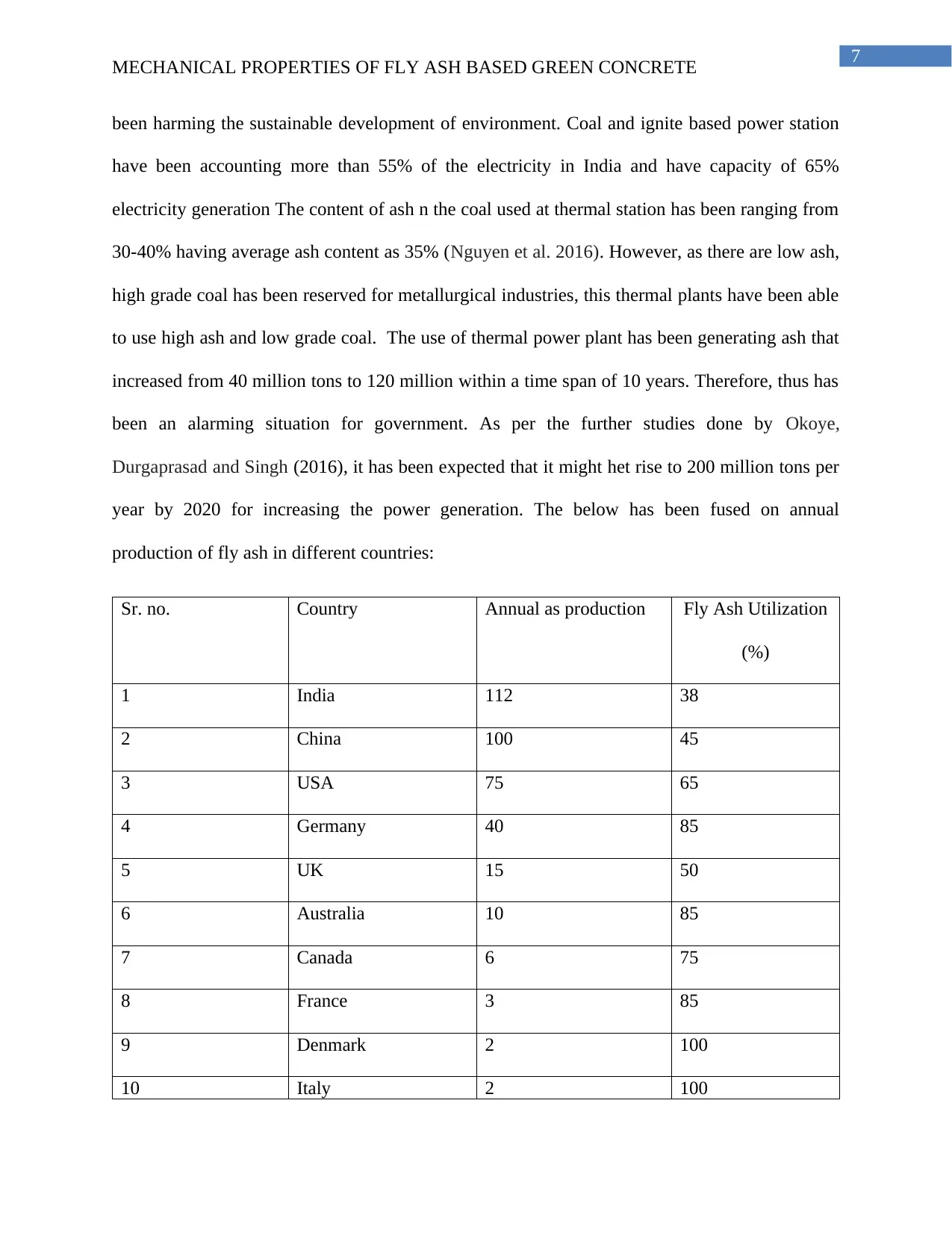
7
MECHANICAL PROPERTIES OF FLY ASH BASED GREEN CONCRETE
been harming the sustainable development of environment. Coal and ignite based power station
have been accounting more than 55% of the electricity in India and have capacity of 65%
electricity generation The content of ash n the coal used at thermal station has been ranging from
30-40% having average ash content as 35% (Nguyen et al. 2016). However, as there are low ash,
high grade coal has been reserved for metallurgical industries, this thermal plants have been able
to use high ash and low grade coal. The use of thermal power plant has been generating ash that
increased from 40 million tons to 120 million within a time span of 10 years. Therefore, thus has
been an alarming situation for government. As per the further studies done by Okoye,
Durgaprasad and Singh (2016), it has been expected that it might het rise to 200 million tons per
year by 2020 for increasing the power generation. The below has been fused on annual
production of fly ash in different countries:
Sr. no. Country Annual as production Fly Ash Utilization
(%)
1 India 112 38
2 China 100 45
3 USA 75 65
4 Germany 40 85
5 UK 15 50
6 Australia 10 85
7 Canada 6 75
8 France 3 85
9 Denmark 2 100
10 Italy 2 100
MECHANICAL PROPERTIES OF FLY ASH BASED GREEN CONCRETE
been harming the sustainable development of environment. Coal and ignite based power station
have been accounting more than 55% of the electricity in India and have capacity of 65%
electricity generation The content of ash n the coal used at thermal station has been ranging from
30-40% having average ash content as 35% (Nguyen et al. 2016). However, as there are low ash,
high grade coal has been reserved for metallurgical industries, this thermal plants have been able
to use high ash and low grade coal. The use of thermal power plant has been generating ash that
increased from 40 million tons to 120 million within a time span of 10 years. Therefore, thus has
been an alarming situation for government. As per the further studies done by Okoye,
Durgaprasad and Singh (2016), it has been expected that it might het rise to 200 million tons per
year by 2020 for increasing the power generation. The below has been fused on annual
production of fly ash in different countries:
Sr. no. Country Annual as production Fly Ash Utilization
(%)
1 India 112 38
2 China 100 45
3 USA 75 65
4 Germany 40 85
5 UK 15 50
6 Australia 10 85
7 Canada 6 75
8 France 3 85
9 Denmark 2 100
10 Italy 2 100
Paraphrase This Document
Need a fresh take? Get an instant paraphrase of this document with our AI Paraphraser
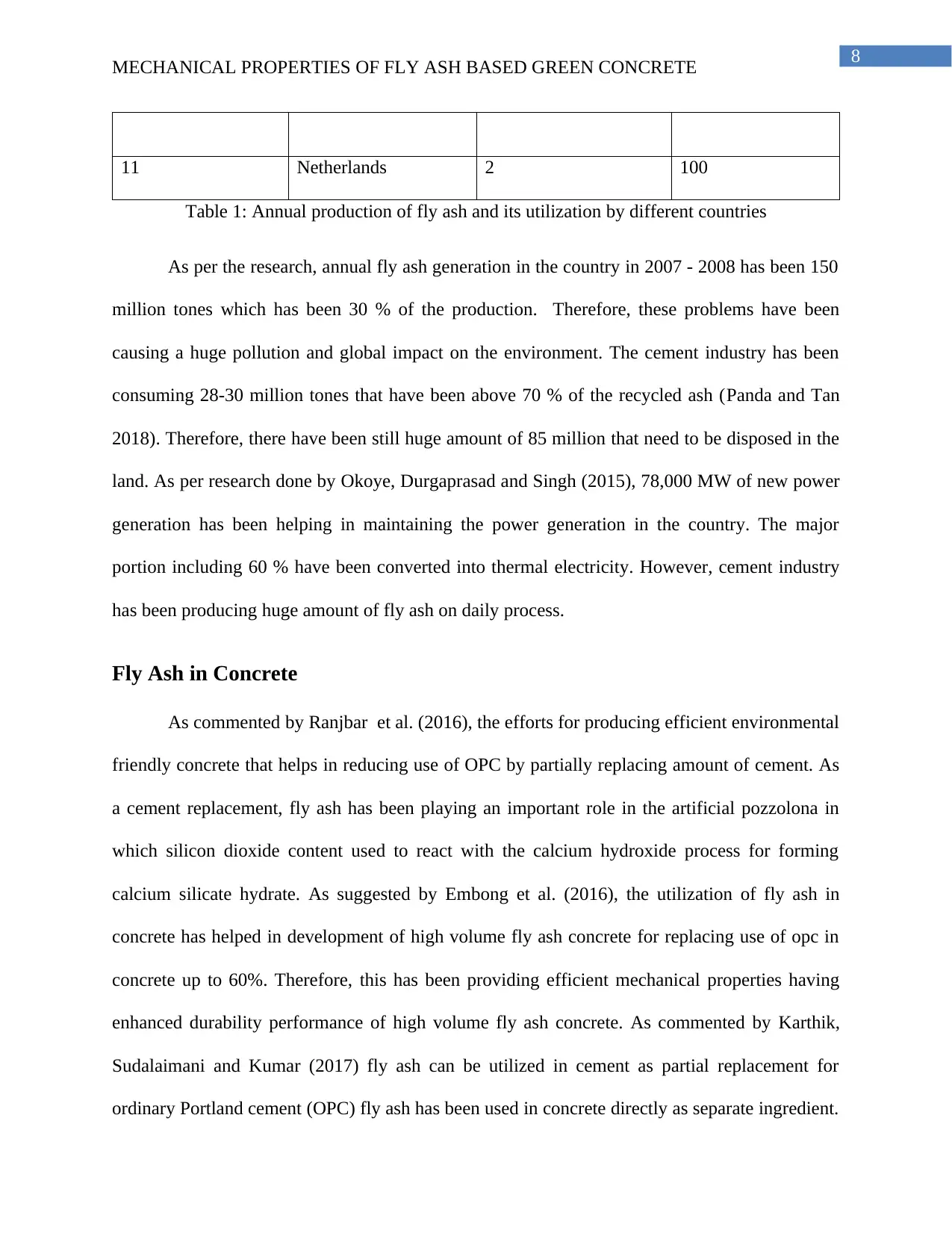
8
MECHANICAL PROPERTIES OF FLY ASH BASED GREEN CONCRETE
11 Netherlands 2 100
Table 1: Annual production of fly ash and its utilization by different countries
As per the research, annual fly ash generation in the country in 2007 - 2008 has been 150
million tones which has been 30 % of the production. Therefore, these problems have been
causing a huge pollution and global impact on the environment. The cement industry has been
consuming 28-30 million tones that have been above 70 % of the recycled ash (Panda and Tan
2018). Therefore, there have been still huge amount of 85 million that need to be disposed in the
land. As per research done by Okoye, Durgaprasad and Singh (2015), 78,000 MW of new power
generation has been helping in maintaining the power generation in the country. The major
portion including 60 % have been converted into thermal electricity. However, cement industry
has been producing huge amount of fly ash on daily process.
Fly Ash in Concrete
As commented by Ranjbar et al. (2016), the efforts for producing efficient environmental
friendly concrete that helps in reducing use of OPC by partially replacing amount of cement. As
a cement replacement, fly ash has been playing an important role in the artificial pozzolona in
which silicon dioxide content used to react with the calcium hydroxide process for forming
calcium silicate hydrate. As suggested by Embong et al. (2016), the utilization of fly ash in
concrete has helped in development of high volume fly ash concrete for replacing use of opc in
concrete up to 60%. Therefore, this has been providing efficient mechanical properties having
enhanced durability performance of high volume fly ash concrete. As commented by Karthik,
Sudalaimani and Kumar (2017) fly ash can be utilized in cement as partial replacement for
ordinary Portland cement (OPC) fly ash has been used in concrete directly as separate ingredient.
MECHANICAL PROPERTIES OF FLY ASH BASED GREEN CONCRETE
11 Netherlands 2 100
Table 1: Annual production of fly ash and its utilization by different countries
As per the research, annual fly ash generation in the country in 2007 - 2008 has been 150
million tones which has been 30 % of the production. Therefore, these problems have been
causing a huge pollution and global impact on the environment. The cement industry has been
consuming 28-30 million tones that have been above 70 % of the recycled ash (Panda and Tan
2018). Therefore, there have been still huge amount of 85 million that need to be disposed in the
land. As per research done by Okoye, Durgaprasad and Singh (2015), 78,000 MW of new power
generation has been helping in maintaining the power generation in the country. The major
portion including 60 % have been converted into thermal electricity. However, cement industry
has been producing huge amount of fly ash on daily process.
Fly Ash in Concrete
As commented by Ranjbar et al. (2016), the efforts for producing efficient environmental
friendly concrete that helps in reducing use of OPC by partially replacing amount of cement. As
a cement replacement, fly ash has been playing an important role in the artificial pozzolona in
which silicon dioxide content used to react with the calcium hydroxide process for forming
calcium silicate hydrate. As suggested by Embong et al. (2016), the utilization of fly ash in
concrete has helped in development of high volume fly ash concrete for replacing use of opc in
concrete up to 60%. Therefore, this has been providing efficient mechanical properties having
enhanced durability performance of high volume fly ash concrete. As commented by Karthik,
Sudalaimani and Kumar (2017) fly ash can be utilized in cement as partial replacement for
ordinary Portland cement (OPC) fly ash has been used in concrete directly as separate ingredient.
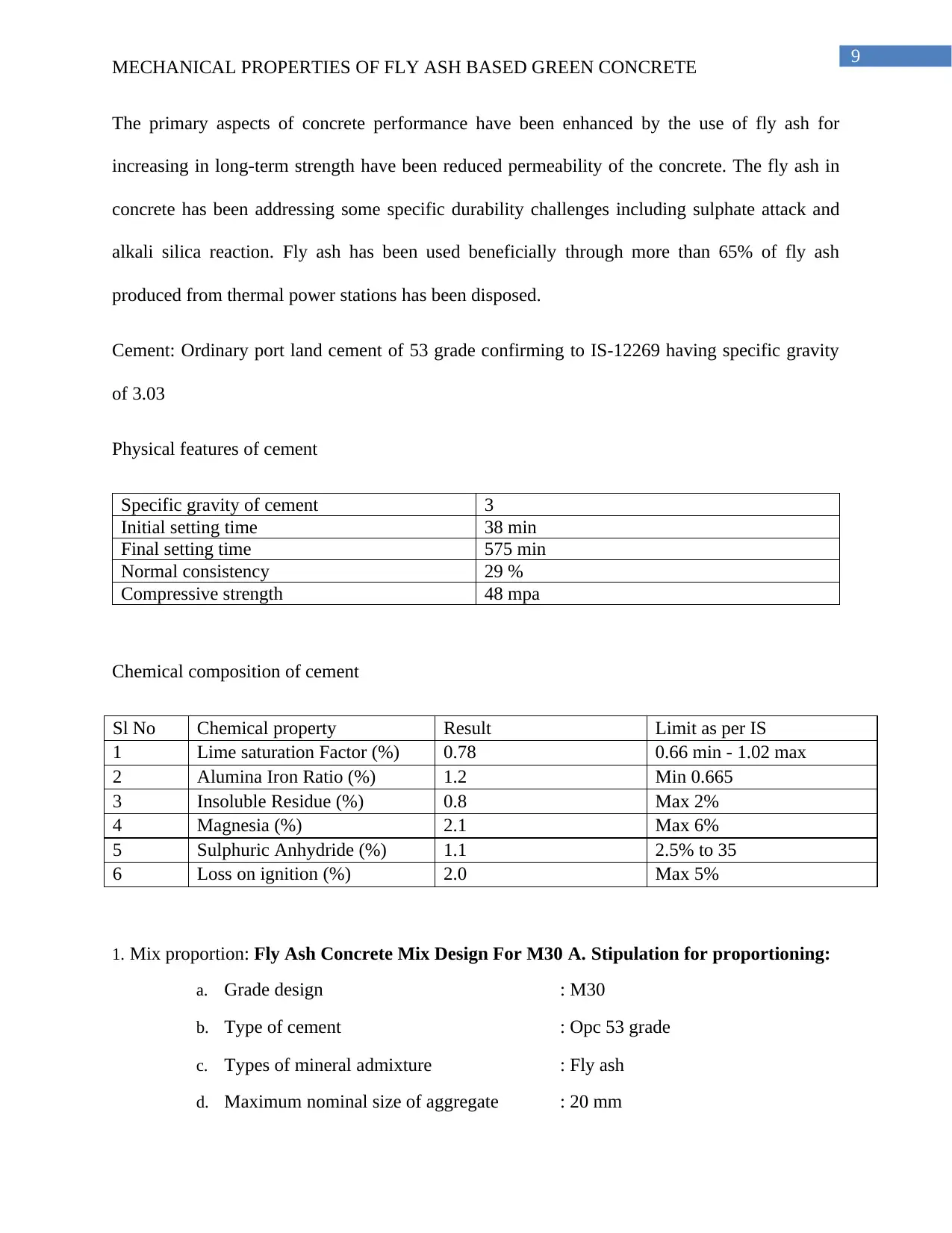
9
MECHANICAL PROPERTIES OF FLY ASH BASED GREEN CONCRETE
The primary aspects of concrete performance have been enhanced by the use of fly ash for
increasing in long-term strength have been reduced permeability of the concrete. The fly ash in
concrete has been addressing some specific durability challenges including sulphate attack and
alkali silica reaction. Fly ash has been used beneficially through more than 65% of fly ash
produced from thermal power stations has been disposed.
Cement: Ordinary port land cement of 53 grade confirming to IS-12269 having specific gravity
of 3.03
Physical features of cement
Specific gravity of cement 3
Initial setting time 38 min
Final setting time 575 min
Normal consistency 29 %
Compressive strength 48 mpa
Chemical composition of cement
Sl No Chemical property Result Limit as per IS
1 Lime saturation Factor (%) 0.78 0.66 min - 1.02 max
2 Alumina Iron Ratio (%) 1.2 Min 0.665
3 Insoluble Residue (%) 0.8 Max 2%
4 Magnesia (%) 2.1 Max 6%
5 Sulphuric Anhydride (%) 1.1 2.5% to 35
6 Loss on ignition (%) 2.0 Max 5%
1. Mix proportion: Fly Ash Concrete Mix Design For M30 A. Stipulation for proportioning:
a. Grade design : M30
b. Type of cement : Opc 53 grade
c. Types of mineral admixture : Fly ash
d. Maximum nominal size of aggregate : 20 mm
MECHANICAL PROPERTIES OF FLY ASH BASED GREEN CONCRETE
The primary aspects of concrete performance have been enhanced by the use of fly ash for
increasing in long-term strength have been reduced permeability of the concrete. The fly ash in
concrete has been addressing some specific durability challenges including sulphate attack and
alkali silica reaction. Fly ash has been used beneficially through more than 65% of fly ash
produced from thermal power stations has been disposed.
Cement: Ordinary port land cement of 53 grade confirming to IS-12269 having specific gravity
of 3.03
Physical features of cement
Specific gravity of cement 3
Initial setting time 38 min
Final setting time 575 min
Normal consistency 29 %
Compressive strength 48 mpa
Chemical composition of cement
Sl No Chemical property Result Limit as per IS
1 Lime saturation Factor (%) 0.78 0.66 min - 1.02 max
2 Alumina Iron Ratio (%) 1.2 Min 0.665
3 Insoluble Residue (%) 0.8 Max 2%
4 Magnesia (%) 2.1 Max 6%
5 Sulphuric Anhydride (%) 1.1 2.5% to 35
6 Loss on ignition (%) 2.0 Max 5%
1. Mix proportion: Fly Ash Concrete Mix Design For M30 A. Stipulation for proportioning:
a. Grade design : M30
b. Type of cement : Opc 53 grade
c. Types of mineral admixture : Fly ash
d. Maximum nominal size of aggregate : 20 mm
⊘ This is a preview!⊘
Do you want full access?
Subscribe today to unlock all pages.

Trusted by 1+ million students worldwide
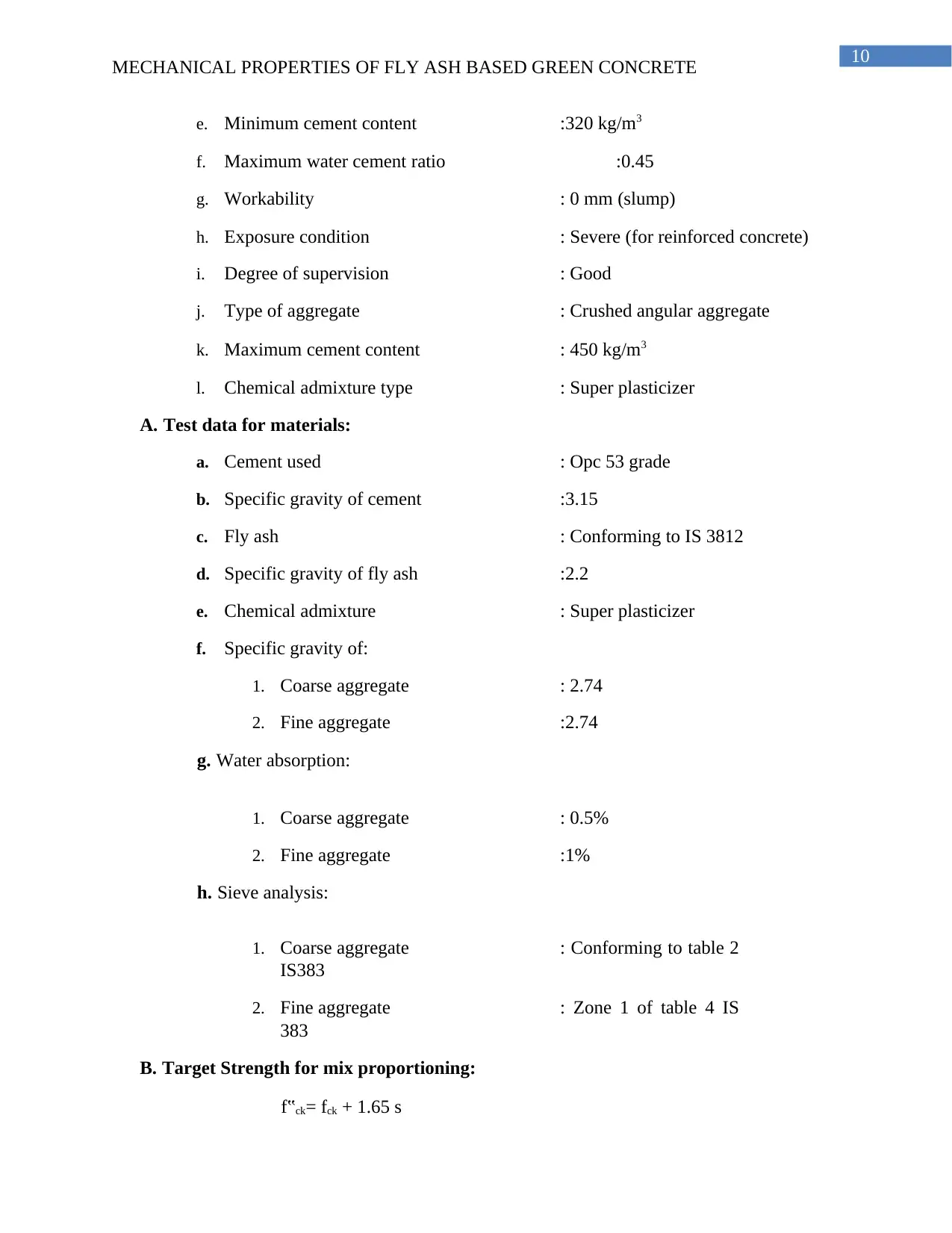
10
MECHANICAL PROPERTIES OF FLY ASH BASED GREEN CONCRETE
e. Minimum cement content :320 kg/m3
f. Maximum water cement ratio :0.45
g. Workability : 0 mm (slump)
h. Exposure condition : Severe (for reinforced concrete)
i. Degree of supervision : Good
j. Type of aggregate : Crushed angular aggregate
k. Maximum cement content : 450 kg/m3
l. Chemical admixture type : Super plasticizer
A. Test data for materials:
a. Cement used : Opc 53 grade
b. Specific gravity of cement :3.15
c. Fly ash : Conforming to IS 3812
d. Specific gravity of fly ash :2.2
e. Chemical admixture : Super plasticizer
f. Specific gravity of:
1. Coarse aggregate : 2.74
2. Fine aggregate :2.74
g. Water absorption:
1. Coarse aggregate : 0.5%
2. Fine aggregate :1%
h. Sieve analysis:
1. Coarse aggregate : Conforming to table 2
IS383
2. Fine aggregate : Zone 1 of table 4 IS
383
B. Target Strength for mix proportioning:
f‟ck= fck + 1.65 s
MECHANICAL PROPERTIES OF FLY ASH BASED GREEN CONCRETE
e. Minimum cement content :320 kg/m3
f. Maximum water cement ratio :0.45
g. Workability : 0 mm (slump)
h. Exposure condition : Severe (for reinforced concrete)
i. Degree of supervision : Good
j. Type of aggregate : Crushed angular aggregate
k. Maximum cement content : 450 kg/m3
l. Chemical admixture type : Super plasticizer
A. Test data for materials:
a. Cement used : Opc 53 grade
b. Specific gravity of cement :3.15
c. Fly ash : Conforming to IS 3812
d. Specific gravity of fly ash :2.2
e. Chemical admixture : Super plasticizer
f. Specific gravity of:
1. Coarse aggregate : 2.74
2. Fine aggregate :2.74
g. Water absorption:
1. Coarse aggregate : 0.5%
2. Fine aggregate :1%
h. Sieve analysis:
1. Coarse aggregate : Conforming to table 2
IS383
2. Fine aggregate : Zone 1 of table 4 IS
383
B. Target Strength for mix proportioning:
f‟ck= fck + 1.65 s
Paraphrase This Document
Need a fresh take? Get an instant paraphrase of this document with our AI Paraphraser
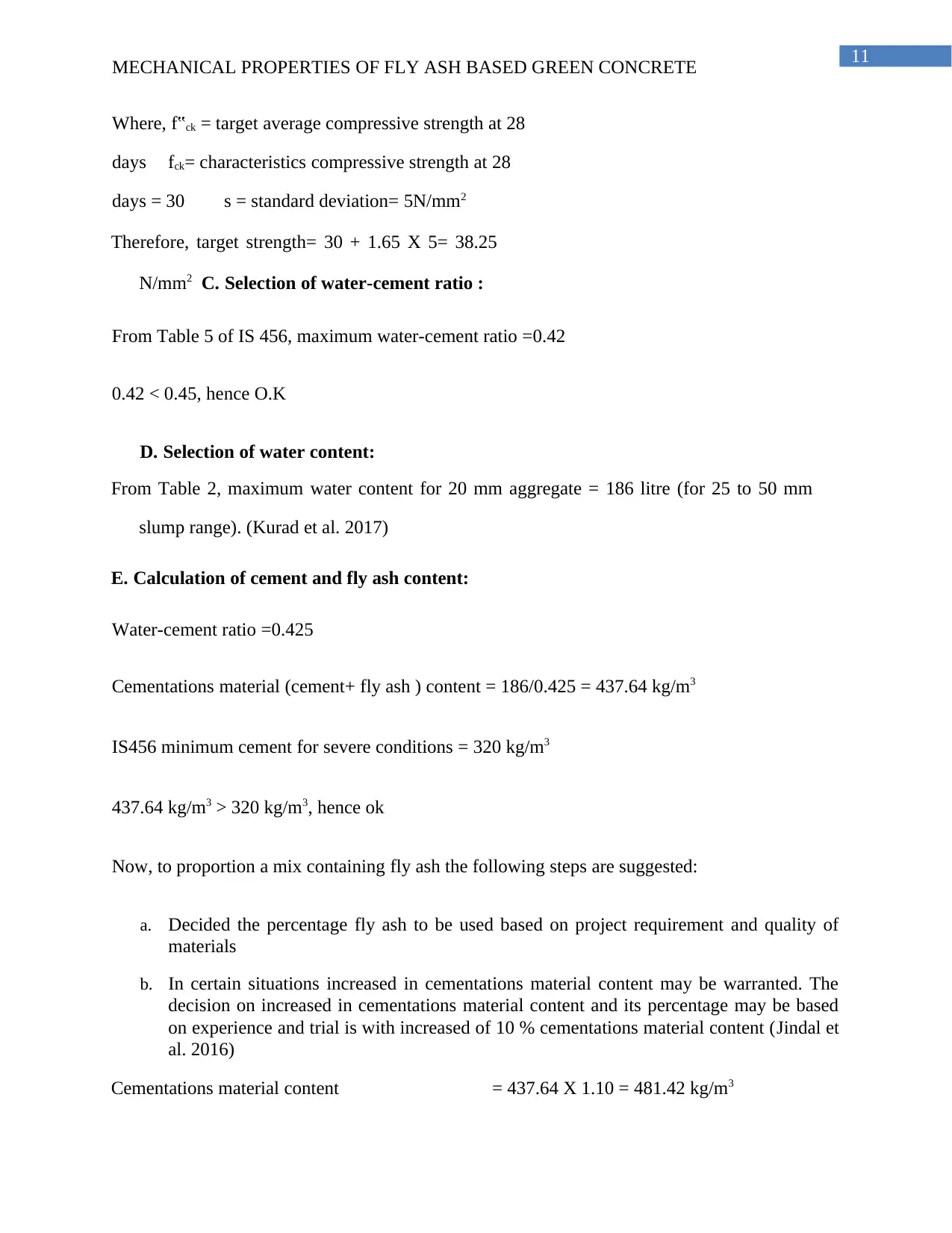
11
MECHANICAL PROPERTIES OF FLY ASH BASED GREEN CONCRETE
Where, f‟ck = target average compressive strength at 28
days fck= characteristics compressive strength at 28
days = 30 s = standard deviation= 5N/mm2
Therefore, target strength= 30 + 1.65 X 5= 38.25
N/mm2 C. Selection of water-cement ratio :
From Table 5 of IS 456, maximum water-cement ratio =0.42
0.42 < 0.45, hence O.K
D. Selection of water content:
From Table 2, maximum water content for 20 mm aggregate = 186 litre (for 25 to 50 mm
slump range). (Kurad et al. 2017)
E. Calculation of cement and fly ash content:
Water-cement ratio =0.425
Cementations material (cement+ fly ash ) content = 186/0.425 = 437.64 kg/m3
IS456 minimum cement for severe conditions = 320 kg/m3
437.64 kg/m3 > 320 kg/m3, hence ok
Now, to proportion a mix containing fly ash the following steps are suggested:
a. Decided the percentage fly ash to be used based on project requirement and quality of
materials
b. In certain situations increased in cementations material content may be warranted. The
decision on increased in cementations material content and its percentage may be based
on experience and trial is with increased of 10 % cementations material content (Jindal et
al. 2016)
Cementations material content = 437.64 X 1.10 = 481.42 kg/m3
MECHANICAL PROPERTIES OF FLY ASH BASED GREEN CONCRETE
Where, f‟ck = target average compressive strength at 28
days fck= characteristics compressive strength at 28
days = 30 s = standard deviation= 5N/mm2
Therefore, target strength= 30 + 1.65 X 5= 38.25
N/mm2 C. Selection of water-cement ratio :
From Table 5 of IS 456, maximum water-cement ratio =0.42
0.42 < 0.45, hence O.K
D. Selection of water content:
From Table 2, maximum water content for 20 mm aggregate = 186 litre (for 25 to 50 mm
slump range). (Kurad et al. 2017)
E. Calculation of cement and fly ash content:
Water-cement ratio =0.425
Cementations material (cement+ fly ash ) content = 186/0.425 = 437.64 kg/m3
IS456 minimum cement for severe conditions = 320 kg/m3
437.64 kg/m3 > 320 kg/m3, hence ok
Now, to proportion a mix containing fly ash the following steps are suggested:
a. Decided the percentage fly ash to be used based on project requirement and quality of
materials
b. In certain situations increased in cementations material content may be warranted. The
decision on increased in cementations material content and its percentage may be based
on experience and trial is with increased of 10 % cementations material content (Jindal et
al. 2016)
Cementations material content = 437.64 X 1.10 = 481.42 kg/m3
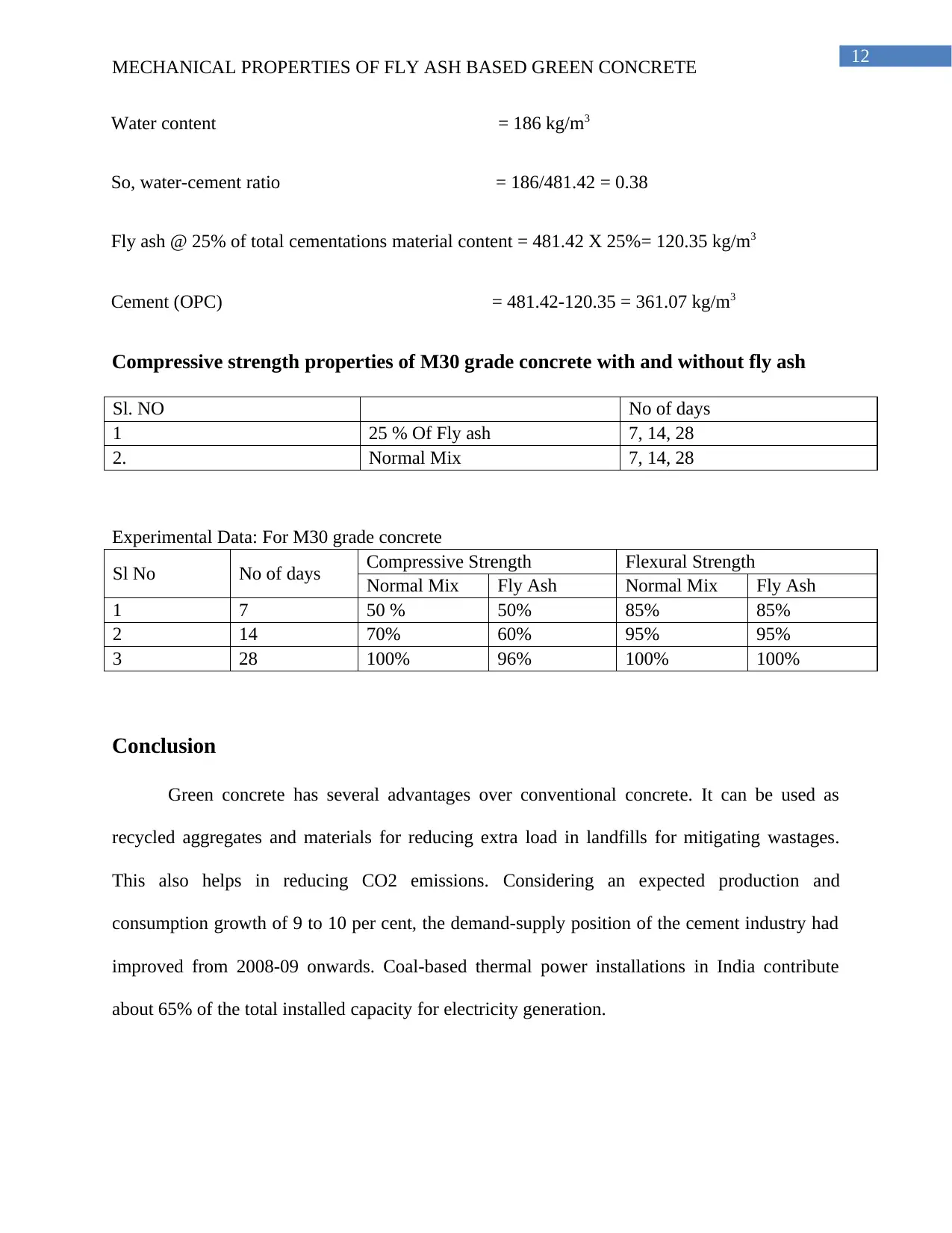
12
MECHANICAL PROPERTIES OF FLY ASH BASED GREEN CONCRETE
Water content = 186 kg/m3
So, water-cement ratio = 186/481.42 = 0.38
Fly ash @ 25% of total cementations material content = 481.42 X 25%= 120.35 kg/m3
Cement (OPC) = 481.42-120.35 = 361.07 kg/m3
Compressive strength properties of M30 grade concrete with and without fly ash
Sl. NO No of days
1 25 % Of Fly ash 7, 14, 28
2. Normal Mix 7, 14, 28
Experimental Data: For M30 grade concrete
Sl No No of days Compressive Strength Flexural Strength
Normal Mix Fly Ash Normal Mix Fly Ash
1 7 50 % 50% 85% 85%
2 14 70% 60% 95% 95%
3 28 100% 96% 100% 100%
Conclusion
Green concrete has several advantages over conventional concrete. It can be used as
recycled aggregates and materials for reducing extra load in landfills for mitigating wastages.
This also helps in reducing CO2 emissions. Considering an expected production and
consumption growth of 9 to 10 per cent, the demand-supply position of the cement industry had
improved from 2008-09 onwards. Coal-based thermal power installations in India contribute
about 65% of the total installed capacity for electricity generation.
MECHANICAL PROPERTIES OF FLY ASH BASED GREEN CONCRETE
Water content = 186 kg/m3
So, water-cement ratio = 186/481.42 = 0.38
Fly ash @ 25% of total cementations material content = 481.42 X 25%= 120.35 kg/m3
Cement (OPC) = 481.42-120.35 = 361.07 kg/m3
Compressive strength properties of M30 grade concrete with and without fly ash
Sl. NO No of days
1 25 % Of Fly ash 7, 14, 28
2. Normal Mix 7, 14, 28
Experimental Data: For M30 grade concrete
Sl No No of days Compressive Strength Flexural Strength
Normal Mix Fly Ash Normal Mix Fly Ash
1 7 50 % 50% 85% 85%
2 14 70% 60% 95% 95%
3 28 100% 96% 100% 100%
Conclusion
Green concrete has several advantages over conventional concrete. It can be used as
recycled aggregates and materials for reducing extra load in landfills for mitigating wastages.
This also helps in reducing CO2 emissions. Considering an expected production and
consumption growth of 9 to 10 per cent, the demand-supply position of the cement industry had
improved from 2008-09 onwards. Coal-based thermal power installations in India contribute
about 65% of the total installed capacity for electricity generation.
⊘ This is a preview!⊘
Do you want full access?
Subscribe today to unlock all pages.

Trusted by 1+ million students worldwide
1 out of 15
Related Documents
Your All-in-One AI-Powered Toolkit for Academic Success.
+13062052269
info@desklib.com
Available 24*7 on WhatsApp / Email
![[object Object]](/_next/static/media/star-bottom.7253800d.svg)
Unlock your academic potential
Copyright © 2020–2025 A2Z Services. All Rights Reserved. Developed and managed by ZUCOL.




